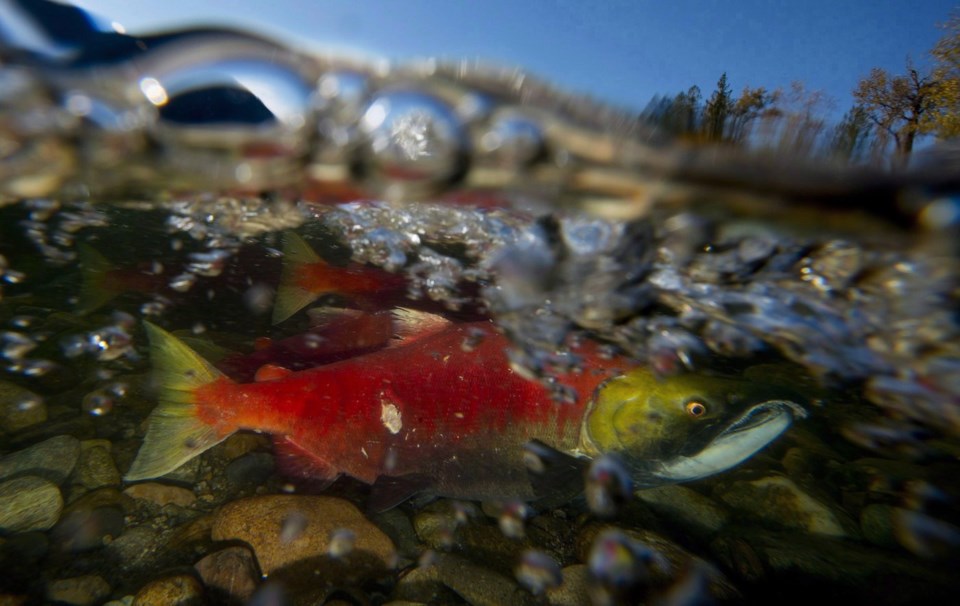VANCOUVER — British Columbia anglers have been standing shoulder to shoulder on stretches of the Fraser River this week, hoping to hook a sockeye salmon during a rare recreational opportunity to catch one of the tastiest and most prized salmon species.
But fisheries experts are cautioning that this year’s strong sockeye returns on the Fraser should not distract from longer-term declines in salmon populations.
The recreational opening comes amid a bumper run of sockeye on the Fraser that the joint Canada-US Pacific Salmon Commission predicted would be 9.1 million fish in a forecast issued on Friday, which would make it the biggest return since 2018.
William Cheung, an associate professor at the Institute for the Oceans and Fisheries at the University of British Columbia, said it's a great sign to see the big returns this year.
But Cheung said there was a need to understand the broader picture of the "past and current status" of salmon on the B.C. coast.
"Although this year is good, it is in the context that the salmon have not been doing really well in the past, and it will continue even though we have a good year this year," he said.
A report co-authored by Cheung says wild salmon stocks have been declining in the Pacific Northwest since the late 1990s, while an extensive 2019 report on the state of Pacific salmon numbers by the Fisheries Department said chinook, coho and sockeye were all in decline in southern B.C. waters.
Cheung said Pacific salmon populations have been broadly declining for decades, citing multiple factors including climate change.
"We are also seeing habitat changes, from logging and also from other climatically related extreme events," said Cheung, adding that, for example, flooding and droughts had affected streams that are crucial for salmon spawning.
Cheung said fluctuating abundance of salmon runs is not a new phenomenon.
The recreational fishing opening on the non-tidal stretch of the Fraser from Mission upstream to the Alexandra Bridge, 40 kilometres north of Hope, lasts until Sept. 1. Tidal waters downstream from Mission to the Fraser mouth are open until Sept. 2, with a bag limit of two sockeye per day on both stretches.
It's the first recreational sockeye opening on the Fraser since 2022.
Greg Taylor, fisheries adviser for the Watershed Watch Salmon Society, said although it's a "wonderful and exciting year" for salmon, we "have to be careful when we say salmon are doing well since they're doing about the same as they used to."
Taylor said the abundance of salmon on the coast this year is due to favourable ocean conditions in the Salish Sea, while some pointed to the removal of salmon farms.
"I think in general, it's just the ocean environment and the environments in the Salish Sea are much improved," said Taylor.
He said most salmon mortality happened as they left the stream or lake where they were hatched, and when they entered the Salish Sea.
"If those conditions are pretty good, they can have really good returns, and I think that's what we're seeing," said Taylor.
However, Taylor said overall salmon populations had shown a "startling and disturbing decline all over this province for the last number of years," mostly driven by climate change in the ocean environment.
But Taylor said that within that decline, we can still have abundances.
"You can have a good sockeye season, or you can have lots of coho around," said Taylor.
Taylor said good salmon runs offer fishing opportunities that "we shouldn't lose sight of."
"I think it's critical that people fish because it connects people to salmon, and if people aren't connected to salmon, we can't work to save them," said Taylor.
He said another way to connect with the phenomenon is to go see a spawning stream.
"It's spectacular," said Taylor. "It's quite an event for the family to experience what that looks like."
This report by The Canadian Press was first published Aug. 27, 2025.
Nono Shen, The Canadian Press



